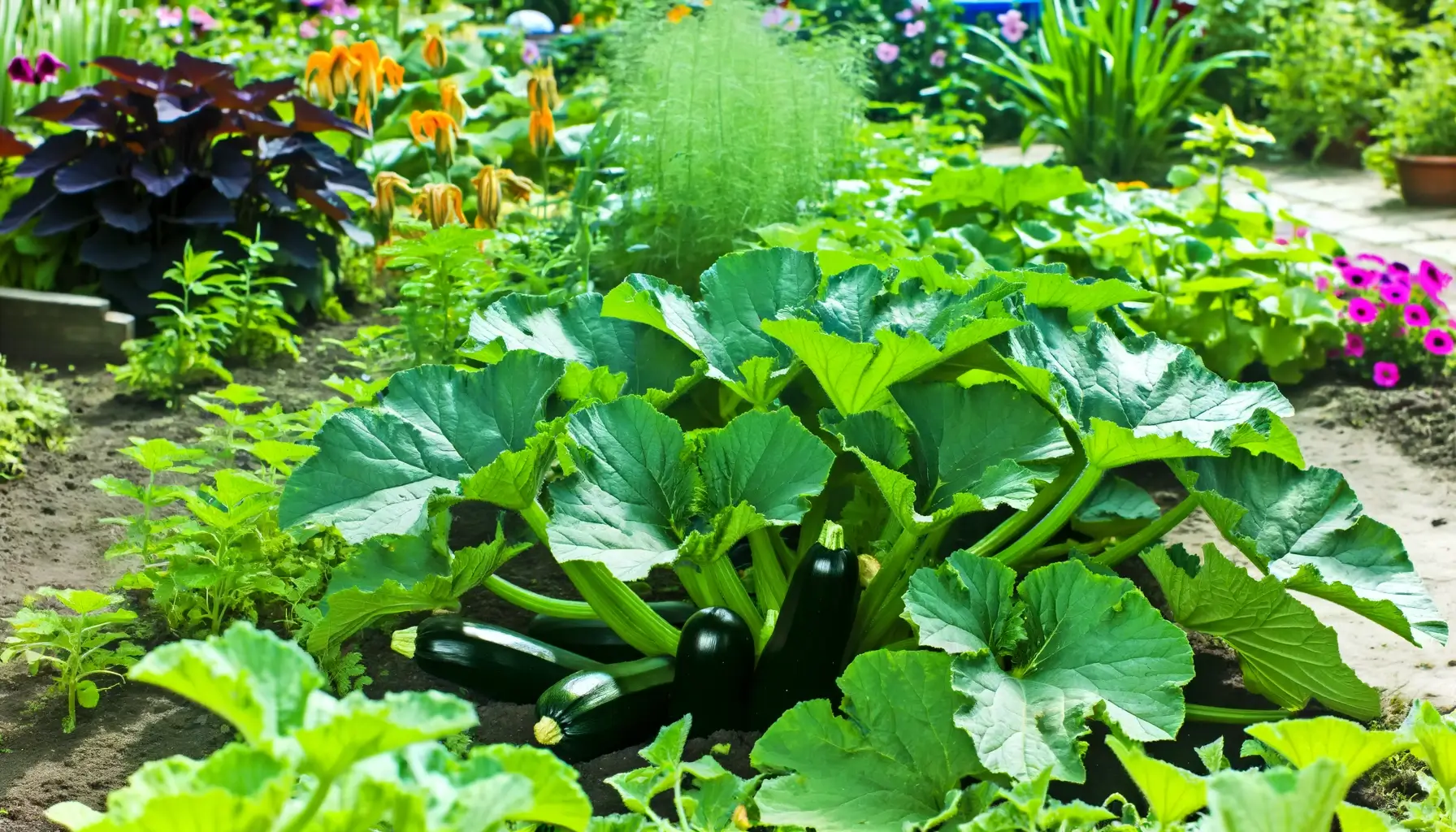It might be a surprise, but the common summer squash, especially the Black Beauty Zucchini, can produce more than 9 pounds of fruit per plant! This prolific yield makes it a garden favorite and an excellent choice for anyone looking to enjoy the rewards of their home gardening efforts. With their distinct, rich dark green skin and scrumptious taste, these zucchinis are a true treasure for culinary enthusiasts. And the best part? They're incredibly easy to grow, even for those just starting to dip their fingers into the soil of the gardening world. Let me show you the sheer joy and excitement of planting seeds and watching them unfurl into verdant vines bursting with squash. Let's learn how to grow black beauty zucchini from seed so you can have more zucchini than you ever wanted! Haha.
Key Takeaways
- Black Beauty Zucchini is a high-yielding summer squash.
- Its striking dark green color makes it as beautiful as it is delicious.
- This variety is easy to grow and perfect for beginners and seasoned gardeners.
- Understanding the process of planting the seeds can enhance the gardening experience.
- The anticipation of germination and growth adds to the gardening adventure.
Black Beauty Zucchini Basics
- Days till maturity: Black Beauty Zucchini typically matures about 50 to 60 days after planting.
- Planting depth: Seeds should be planted about 1 inch (2.5 cm) deep.
- Plant spacing: Space plants about 24 to 36 inches (60 to 90 cm) apart in rows 3 to 8 feet (0.9 to 2.4 meters).
- Days to germination: Germination usually occurs in 7 to 14 days, depending on soil temperature.
- Indoors or Direct Sown: Zucchini can be started indoors 2 to 4 weeks before the last frost date or sown directly into the garden after the danger of frost has passed.
- Full Sun or Partial Shade: Black Beauty Zucchini requires full sun to thrive.
- When to harvest: Harvest when the fruits are 6 to 8 inches (15 to 20 cm) long, which usually takes about 50 to 60 days after planting.
- How tall does the plant grow? It can grow about 24 to 36 inches (60 to 90 cm) tall.
- How wide does the plant get? The plant can spread about 24 to 48 inches (60 to 120 cm) wide.
- Native: Zucchini is native to Central America and Mexico.
- Family: Black Beauty Zucchini is part of the Cucurbitaceae family, which includes squash, cucumbers, and melons.
Black Beauty Zucchini Seeds
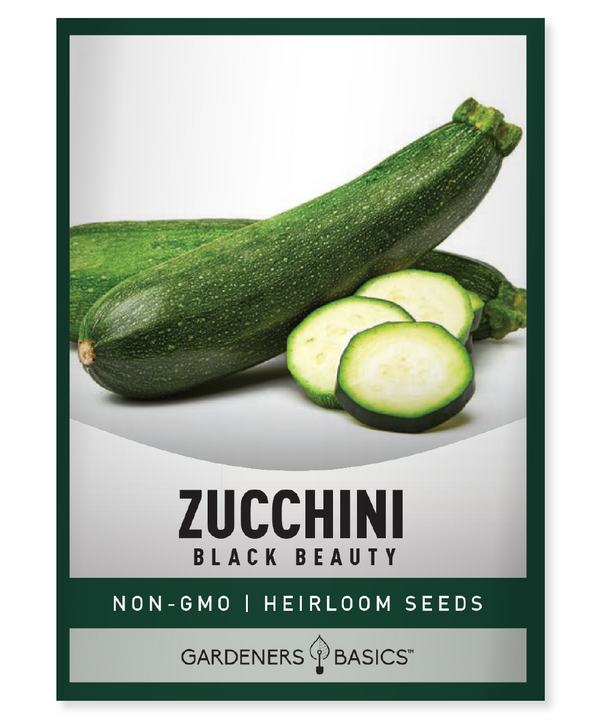
$2.49
Black Beauty Zucchini Seeds - Heirloom, Non-GMO, Non-Hybrid, Open-Pollinated - Perfect for Your Garden! Discover the joy of growing your own Black Beauty Zucchini, a classic heirloom variety known for its high yield and deliciously tender fruit. Our seeds are… read more
Understanding Black Beauty Zucchini
When I started gardening, the allure of growing my own vegetables from seed was strong, but the uncertainty of success was a looming concern. The Black Beauty Zucchini, however, painted a different story with its rewarding and hassle-free cultivation. Let's look at what makes this variety a staple in nationwide gardens.
Characteristics of Black Beauty Zucchini
The Black Beauty Zucchini is renowned for its ability to thrive in various climates, a testament to its easy-to-grow nature. The squash features an alluring dark green skin that gives it a distinct aesthetic appeal and signifies its rich flavor profile. As the zucchinis mature, they typically reach several inches long, often about 6 to 8 inches, the perfect size for many dishes from stir-fries to zucchini bread.
| Garden Attribute | Description |
|---|---|
| Size | 6-8 inches long |
| Color | Rich dark green |
| Growth | Easy to cultivate |
| Flavor | Mild, slightly sweet |
| Usage | Versatile in recipes |
The Popularity of Black Beauty Zucchini among Gardeners
The appeal of this squash doesn't stem solely from its pleasing aesthetics and size. Its popularity skyrockets due to its versatility in the kitchen, allowing home cooks to employ it in countless recipes. What endears it even more to gardeners is the minimal effort it requires; despite minimal care, it yields a bountiful harvest. Whether gracing a plate as a simple roasted side dish or being transformed into a gourmet stuffed entree, the dark green hues of the Black Beauty Zucchini ensure it stands out, creating a visual and gustatory delight. It's resilience and effortless growth contribute greatly to its reputation among green thumbs as the go-to variety for a guaranteed garden win.
Preparing for Planting
Embarking on the journey to cultivate Black Beauty Zucchini starts with meticulously preparing the garden space. Securing a plot with well-drained soil is paramount—it's like laying a foundation for a building; it determines the robustness and longevity of the growth that will take place. Next is ensuring the area receives full sun, as zucchini plants are sun worshipers that thrive with ample sunlight fueling their growth.
Timing the growing season plays a crucial role in successfully cultivating these plants. Sowing seeds too early could result in a frost-bitten garden, while a late start may not give your zucchini adequate time to mature before the fall chill. Thus, aligning the planting schedule with the temperate blessings of spring is key.
Let me share a quick checklist I use to ensure my garden's soil is primed and ready for planting:
- Test the soil for proper drainage by soaking it with water and observing how quickly it drains.
- Add organic compost to enrich the soil and promote good structure, considerably increasing the nutrient content.
- Ensure the soil's pH levels are compatible with zucchini growth, which prefers slightly acidic to neutral soil (pH 6 to 7.5).
- Prepare raised beds if drainage is a concern or if you're working with heavy clay soil.
Remember, nurturing your garden is like crafting an art piece: the canvas's quality defines the colors' brilliance. Whether you're a first-timer or a seasoned gardener, understanding and implementing these fundamental steps can drastically enhance your horticultural narrative, laying down the tracks for a blossoming and bountiful Black Beauty Zucchini harvest.
Non-GMO Squash Seeds | 8 Variety Pack
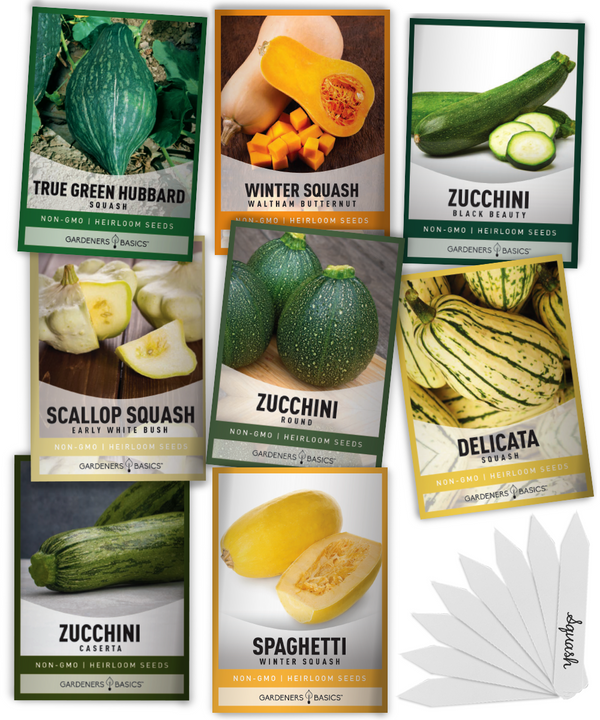
$15.95
Ultimate 8 Squash Seeds Variety Pack for Home Gardeners – Heirloom & Non-GMO Seeds Introducing our 8 Squash Seeds Variety Pack—the ultimate selection for gardeners who love cultivating a diverse range of delicious, homegrown squash! This carefully curated variety pack… read more
Selecting the Right Seeds
As a passionate gardener, I've learned that selecting the right seeds is the first step to a successful zucchini harvest. It's a decision and a pledge to your garden's future health and productivity. High-quality zucchini seeds are essential to increase the likelihood of robust plants and a bountiful harvest. Gardeners Basics, an established brand in the gardening community, offers an excellent choice with our Black Beauty Zucchini seeds, known for our high germination rate and pure genetics.
Planting the Seeds
When it comes to growing Black Beauty Zucchini, timing is everything. Starting your seeds indoors gives you a head start on the growing season, ensuring your seedlings are sturdy and ready for the move outdoors once the danger of frost has passed. While excitedly filling small pots with soil and sowing the seeds may seem like the beginning of your gardening adventure, it's a strategic maneuver centered around the rich opportunity of the sunny months ahead. Proper timing sets the stage for a plentiful harvest under the nourishing rays of full sun.
When to Start Your Seeds Indoors
As I've discovered through seasons of trial and error, the ideal time to begin sowing Black Beauty Zucchini seeds indoors is approximately four to six weeks before the last expected frost. This gives your burgeoning seedlings enough time to develop a strong root system and resilient stem before they're introduced to the outdoor elements. Taking heed of your local climate's idiosyncrasies is paramount—track the historical frost dates and monitor weather forecasts vigilantly. This ensures that planting the seeds indoors aligns with Mother Nature’s calendar.
Transplanting Seedlings After the Danger of Frost Has Passed
Just as the early bird gets the worm, the well-timed transplant of seedlings ensures they benefit from the season's full stretch of full sun. The transition from the controlled environment indoors to the expansive open-air should occur only after the danger of frost has passed. Watch for the leaves of the seedlings to signify their readiness: the presence of two to three true leaves often indicates they're prepared for transplanting. Hardening off your plants is a gentle way to introduce them to outdoor conditions—a week of gradually exposing them to the elements will fortify their resilience against the unpredictable whims of nature. It’s a delicate march towards autonomy that prefigures the summer’s endless dance of growth and sunlight.
Below is the timeline I follow to ensure that my Black Beauty Zucchini seedlings are perfectly timed for transplanting:
| Activity | Timing |
|---|---|
| Start seeds indoors | 4-6 weeks before the last frost |
| Monitor seedling growth | Weekly |
| Begin hardening off the process | 1 week before transplanting |
| Transplant outdoors | After the last frost, when the soil temperature is above 60°F |
Achieving a flourishing zucchini patch requires acute attention to these timelines. With patience and precision, your garden will soon bask in the glory of robust Black Beauty Zucchini vines reveling in the full sun, promising a bounty that marks both the gardener’s prowess and nature’s munificence.
Optimal Growing Conditions for Zucchini Seeds
As an enthusiastic gardener, nothing thrills me more than sharing the essentials for a thriving garden. Today, I'm focusing on zucchini, a staple in the home garden that's as easy to grow as it is satisfying to harvest. Some key environmental conditions must be considered to ensure your Black Beauty Zucchini reaches its full potential.
Zucchini plants are sun-lovers. They flourish under full sun and require ample daylight to develop their signature dark green, nutrient-rich fruits. The ideal spot in your garden is where these plants can bask in sunlight for most of the day.
Another critical factor in growing zucchini is well-drained soil. These plants dislike soggy feet, so ensuring excess water can easily exit the soil is paramount for avoiding root rot and other moisture-related diseases.
Those just starting out will be pleased to know that zucchinis are easy to grow, provided they are given the right love and attention. Below, I've detailed a table outlining the perfect growing conditions for those aspiring to cultivate their zucchini bounty.
| Condition | Why It's Important | How to Achieve It |
|---|---|---|
| Full Sun | Maximizes photosynthesis for vigorous growth | Plant in the sunniest part of your garden |
| Well-Drained Soil | Prevents root rot and other diseases | Amend your soil with organic matter or create raised beds |
| Space Between Plants | Encourages healthy air circulation | Follow seed packet instructions on spacing or plant about 24 inches apart |
| Regular Watering | Keeps soil consistently moist, not waterlogged | Water deeply once per week or adjust according to temperature and rainfall |
| Warm Soil | Promotes seed germination and healthy root development | Wait to plant until the soil temperature remains above 60°F |
| Soil Nutrients | Fuels growth and fruit production | Add a balanced fertilizer or compost to the soil before planting |
Note that while easy to grow is often associated with zucchini, it doesn't mean they grow without input. As with most things in the garden, your early efforts to provide these optimal conditions will result in lush, productive plants that can truly thrive throughout the season.
In conclusion, you're setting up your zucchini seeds for success by ensuring full sun, well-drained soil, and the right temperature. Embrace these tips, and watch as your garden becomes a haven for these delightful summer squashes.
How To Grow Black Beauty Zucchini From Seed
Embarking on the journey to grow Black Beauty Zucchini starts with the magic and science behind the process where a seed germinates. Witnessing the tiny zucchini seeds crack open to reveal the first signs of life reminds us of the wonders of nature and the simplicity of growing your own food. Let's guide you through the stages of seed germination, followed by essential tips to care for your zucchini seedlings, emphasizing just how easy these plants can be to grow.
The Stages of Seed Germination
Gardeners often marvel at how a single zucchini seed transitions into a sprout that eventually matures into a producing plant. The germination journey is critical, laying the foundation for a healthy zucchini crop. Here's a closer look:
- Imbibition: The seed rapidly absorbs water, swelling and breaking through its coat.
- Respiration: As water activates enzymes, the seed’s metabolism kickstarts, using stored reserves to fuel growth.
- Radicle emergence: The first root pushes through the seed coat, anchoring into the soil.
- Shoot emergence: The young shoot (hypocotyl) straightens, lifting the seed leaves (cotyledons) above ground.
- True leaves: After the cotyledons, true leaves develop, differentiated by their structure, to start photosynthesis.
Each step of this sequence is a milestone indicating a successful germination if the environmental conditions support it – adequate moisture, the right temperature range, and good soil quality. It's essential to constantly monitor these conditions to ensure the zucchini seeds don't encounter any hindrances in their germination journey.
Caring for Your Zucchini Seedlings
Post-germination, zucchini seedlings enter a vulnerable phase that commands gentle yet vigilant care. As they sprout, maintaining the right environment is crucial. Here's what I've found works best:
- Keep the soil moist but not waterlogged to encourage strong root growth.
- Provide warmth by using a heat mat or placing seedlings in a warm area to promote sturdy stems.
- Ensure they receive sufficient light from a sunny window or supplemental grow lights for at least 6-8 hours daily.
- Once true leaves appear, begin a light feeding with a diluted liquid fertilizer to support healthy foliage.
- Gradually introduce seedlings to the outdoors to acclimate them, a process known as hardening off.
With a nurturing start, these seedlings will soon become substantial plants eager to produce. The ease with which Black Beauty Zucchini grows is a delight for gardeners at any experience level. By understanding these early stages of life, from when the seed germinates until the seedling is established, you prepare to nurture these easy-to-grow zucchinis to a plentiful harvest.
Heirloom Squash Seeds | 5 Variety Pack

$9.95
5 Squash Seeds Variety Pack: Heirloom, Non-GMO, Open-Pollinated Squash Seeds for Vegetable Gardening Our 5 Squash Seeds Variety Pack is the ultimate collection for garden enthusiasts and squash lovers! Whether you're' a seasoned gardener or just starting out, this heirloom… read more
Heirloom Squash Seeds | 5 Variety Pack
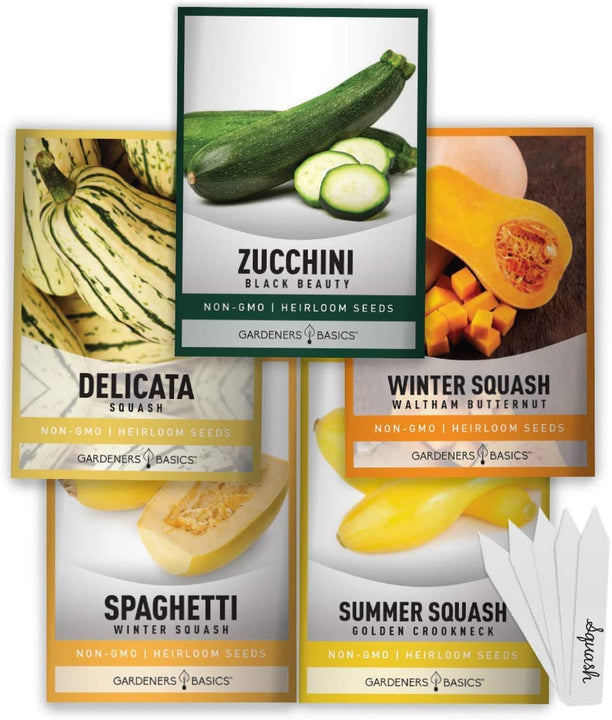
$9.95
5 Squash Seeds Variety Pack: Heirloom, Non-GMO, Open-Pollinated Squash Seeds for Vegetable Gardening Our 5 Squash Seeds Variety Pack is the ultimate collection for garden enthusiasts and squash lovers! Whether you're' a seasoned gardener or just starting out, this heirloom… read more
Maintaining Your Black Beauty Zucchini Plants
Growing zucchinis can delight any gardener, particularly when cultivating the robust and rewarding Black Beauty variety. Known for their ease of care and prolific nature, these summer squash plants do best when provided with full sun, a steady supply of water, and well-drained soil. Follow these tips to maintain your plants and ensure they continue to grow easily.
The key elements in zucchini plant maintenance include appropriate watering, feeding, and vigilance against pests and diseases. Let's break down these elements to secure a healthy life for your zucchinis:
- Watering: Zucchini plants love moisture, but avoiding waterlogging is essential. Aim for one inch of water per week, allowing deep soil penetration.
- Feeding: These hearty plants benefit from regular fertilization. An all-purpose vegetable garden fertilizer applied every four weeks will support healthy growth.
- Sun Exposure: Black Beauty Zucchini is a sun worshipper. It thrives in full sun and requires a minimum of 6 to 8 hours of direct sunlight daily.
As with any garden endeavor, being proactive about pests and diseases can save you a lot of trouble. Here's a table that outlines common issues and preventive measures:
| Common Issue | Preventive Measure | Benefit |
|---|---|---|
| Squash Vine Borer | Apply floating row covers or introduce nematodes. | Protects stems and ensures plant health. |
| Powdery Mildew | Water at the base of plants; avoid overhead watering. | Reduces leaf humidity, preventing the spread of fungus. |
| Aphids | Use water spray or natural predators like ladybugs. | Keeps sap-sucking pests at bay, preventing growth stunts. |
| Blossom End Rot | Ensure even watering and calcium-rich soil. | Prevents fruit decay, leading to a better harvest. |
| Cucumber Beetles | Hand-pick or use organic pesticides. | Minimizes crop damage and disease transmission. |
Full sun, easy-to-grow, and well-drained soil are more than just keywords; they are the pillars upon which successful zucchini cultivation rests. By dedicating time to watering, feeding, and monitoring your zucchini plants, you promote a garden that's not only thriving but also a source of pride and produce throughout the growing season.
Harvesting Your Zucchini
As the summer unfolds, your Black Beauty Zucchini will hint at its readiness for harvest. The timing and method of collecting these summer squashes ensure a continuous output, keeping the beds productive throughout the season. Mastering the harvest is not just about reaping the fruits but also about encouraging further flourishing.
Signs that Zucchini is Ready to Harvest
Recognizing when your Black Beauty Zucchini has reached its peak requires close observation. Generally, zucchinis are best picked when they are several inches long, specifically between 6 to 8 inches for this variety, representing the perfect balance of size, flavor, and texture. You'll want to look for the tell-tale signs of shiny, unblemished, dark green skin that's firm to the touch. This visual and tactile bookmark indicates that your summer squash is ripe for picking.
How to Harvest Zucchini to Encourage Further Growth
Approach harvest time with gentleness and precision to avoid damaging the plants. Utilize a sharp knife or pruning shears, cutting the zucchini off the vine rather than pulling or twisting. Leave a short stem on each squash to improve its shelf life and prevent damage to the plant. This method not only preserves the integrity of the plant but also stimulates it to produce more fruit. Harvesting early and often is also a key practice, as frequent harvesting encourages plants to yield more generously. Consistent harvesting will ensure a regular offering of Black Beauty Zucchini to grace your table or to share with loved ones.
| Harvest Indicator | Details |
|---|---|
| Length | 6-8 inches long |
| Appearance | Dark green, glossy skin without blemishes |
| Texture | Firm to the touch |
| Technique | Cut with a sharp knife or pruning shears, leaving a stem |
| Frequency | Regularly to stimulate continuous production |
In essence, paying close attention to the size and appearance of your zucchini will guide you in reaping them at the optimal time. Adhering to the recommended harvest method not only preserves the vitality of your plants but also enhances the health and longevity of the fruits and the vines. Through careful and attentive harvest practices, your Black Beauty Zucchini plants will become the gifts that keep giving throughout the warm months.
Conclusion - Growing Black Beauty Zucchini's
As the days grow shorter and the breezy whispers of fall approach, the diligent efforts invested into nurturing Black Beauty Zucchini yield a palette of dark green, ready to be enjoyed in many ways. The delight of homegrown squash does not have to be a fleeting summer romance; there are tangible ways to extend this relationship, savoring every moment well into the cooler months. It brings me immense satisfaction to share insights on prolonging the harvest, ensuring every ounce of effort blooms into an extended season of freshness and zest.
Prolonging the Harvest Season
To uphold the dynamics of growth and push the boundaries of the zucchini lifecycle, a few strategic measures can secure a longer harvest. Frequent and careful picking signals the plants to continue producing, warding off the complacency that full maturity might instill. By maintaining the vigilant care of watering and feeding, these verdant gems will reward you with longevity. The practice of succession planting—sowing new seeds every few weeks—also optimizes continuance, as younger plants will rise to replace those phasing out.
Sharing the Bounty: Using and Preserving Zucchini
Sharing the bounty of your Black Beauty Zucchini with loved ones is a sense of fulfillment. Whether by surprising neighbors with a fresh squash basket, involving the family in cooking sessions using the garden's dark green goodness, or donating to a local food pantry, the joy of giving cultivates community spirit and gratification. Furthermore, the versatility of zucchini lends itself to preservation. Freeze shredded portions for future baking, pickle slices for savory snacks, or create relish and jams that encapsulate the essence of summer. Each jar seals the flavors and the memory of sun-kissed days tending to your green abundance.
The journey of growing Black Beauty Zucchini, from the tiny seeds to the trailing vines laden with squash, is steeped in learning, patience, and awe. Embrace the moments of stillness in the garden, the bustling activity of bees and butterflies, and the pride of serving a dish crafted from your homegrown produce. The cycle of planting, tending, harvesting, and sharing the bounty is a rewarding rhythm, a natural concerto, enriching the gardener's soul and those partaking in the harvest. As you move forward, may you carry the knowledge and satisfaction of a season well spent and bountiful, and may the dark green treasures from your garden always remind you of the beauty and bounty of nature.
Vegetable Seed Vault Kit | 35 Variety Pack
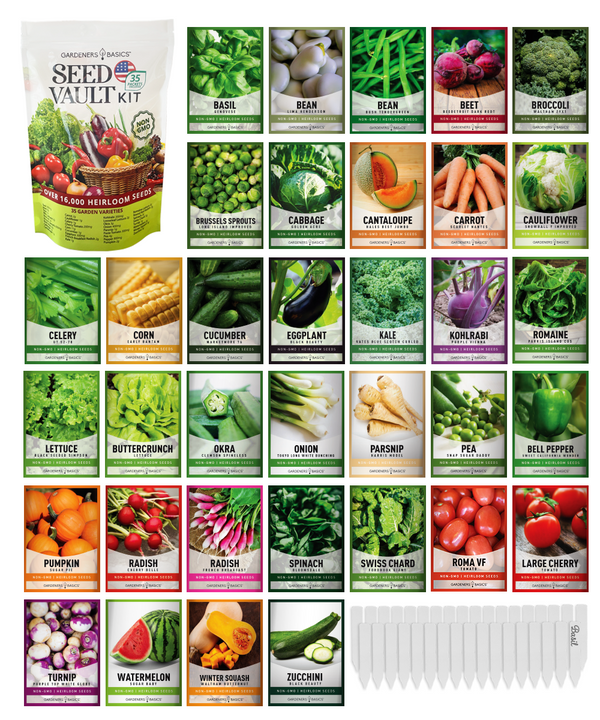
$29.95
$49.95
Ultimate Survival Seed Vault: 16,000+ Non-GMO Heirloom Vegetable Seeds for Emergency Preparedness Introducing the Seed Vault Kit, your all-in-one solution for emergency preparedness and sustainable gardening. This premium seed kit contains over 16,000 non-GMO, Heirloom, Non-Hybrid, and Open Pollinated seeds,… read more
FAQ - How To Grow Black Beauty Zucchini From Seed
How do I start growing Black Beauty Zucchini from seed?
Begin by planting the seeds in well-drained soil, ensuring they're positioned in an area that receives full sun. If you're in a region with a short growing season, start planting indoors and then transplant the seedlings outdoors once the danger of frost has passed.
What makes Black Beauty Zucchini a popular choice among gardeners?
Black Beauty Zucchini is cherished for its easy-to-grow nature, delicious flavor, versatility in the kitchen, and the vibrant dark green color of its summer squash.
When should I plant my Black Beauty Zucchini seeds outdoors?
Plant your seeds outdoors only after the danger of frost has passed and the soil has adequately warmed. This ensures the best germination rates and seedling survival.
Where can I find high-quality Black Beauty Zucchini seeds?
High-quality Black Beauty Zucchini seeds can be purchased from reputable suppliers like Gardeners Basics. Choosing a trusted source ensures you get viable, robust seeds.
What are the optimal growing conditions for zucchini seeds?
Zucchini seeds thrive in well-drained soil, full sun, and a warm environment. If you meet these conditions, zucchini seeds will be easy to grow and nurture.
Can you describe the germination process for Black Beauty Zucchini seeds?
As the zucchini seed germinates, it will first develop a root that anchors it into the soil, followed by the sprout that pushes through the soil surface. The initial leaves, or cotyledons, will then open towards the light.
How can I ensure the health of my Black Beauty Zucchini seedlings?
To care for your seedlings, keep the soil moist but not waterlogged, provide plenty of sunlight, and protect them from extreme weather and pests. As they grow, thin out the seedlings to avoid overcrowding.
What maintenance is required to grow Black Beauty Zucchini plants?
Regular watering, proper sun exposure, and feeding your plants with the right fertilizers are key to maintaining healthy plants. Also, monitoring for pests and diseases and taking preventative measures are important.
How will I know when my Black Beauty Zucchini is ready to harvest?
Your summer squash is ready to harvest when it reaches about 6 to 8 inches long. The skin should be a dark green and slightly firm to the touch.
What's the best way to harvest Black Beauty Zucchini to encourage further growth?
Cut the zucchini from the plant using a sharp knife or pruning shears, leaving a short stem attached. Regular harvesting encourages the plant to produce more fruit throughout the growing season.



